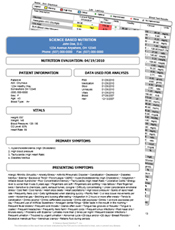What are artificial sweeteners?
Artificial sweeteners are low calorie substances used to replace sugar and other caloric sweeteners. Some common artificial sweeteners include: Aspartame (Equal, Nutrasweet); Acesulfame K (Sunette, Sweet One); Saccharin; Sucralose (Splenda); Xylitol; Sorbital; Maltilol
Where are artificial sweeteners found?
Artificial sweeteners are found in many foods. Some common products that contain artificial sweeteners include, but are not limited to, chewing gum [some gums contain 3-4 artificial and non-artificial sweeteners], chewable vitamins, drinks, toothpaste, mouth wash, cereals, candy, and “sugar free” items. Check your ingredient labels.
Why should I avoid artificial sweeteners?
Saccharin has had a very controversial past. The FDA tried to ban it in 1977 because some animal studies showed that it caused cancer (mainly bladder cancer, but also uterine, ovarian, skin, and others). Saccharin stayed on the market because of pressure from the diet food industry (and the dieters themselves). However, it carried a warning label that stated it had been shown to cause cancer in laboratory animals until the late 1990s. In 2000, the National Cancer Institute [NCI] stated that people who were heavy saccharin users (six or more servings of saccharin or two or more 8-ounce servings of diet drink daily) had “some evidence of an increased risk of bladder cancer, particularly for those who heavily ingested the sweetener as a tabletop sweetener or through diet sodas.” Because of this study and other research with laboratory animals, it was decided that saccharin was not a major risk factor for bladder cancer in humans. We cannot explain this “logic”.
Research in animals has shown that Sucralose, commonly known as Splenda, can cause many problems such as shrunken thymus glands (up to 40 percent shrinkage), enlarged liver and kidneys, atrophy of lymph follicles in the spleen and thymus, reduced growth rate, decreased red blood cell count, hyperplasia of the pelvis, extension of the pregnancy period, aborted pregnancy, decreased fetal body weights and placental weights, and diarrhea.
-Ecologist Online, Life After Aspartame, Sept 8, 2005
-Food and Drug Administration “Final Rule ” for Sucralose, 21 CFR Part 172, Docket No. 87F-0086.
-Lord GH, Newberne PM. Renal mineralization — a ubiquitous lesion in chronic rat studies.
– Food Chem Toxicol 1990 Jun;28:449-55.
-Labare MP, Alexander M. Microbial co-metabolism of sucralose, a chlorinated disaccharide, in environmental samples. Appl Microbiol Biotechnol. 1994 Oct;42:173-8.
-Hunter BT. Sucralose. Consumers’ Research Magazine, Oct90, Vol. 73 Issue 10, p8, 2p.
-Sucralose — a new artificial sweetener. Medical Letter on Drugs & Therapeutics, 07/03/98, Vol. 40, Issue 1030, p67, 2p.
Aspartame, which is sold commercially as Equal and NutraSweet consists of three components: Aspartic acid, Methanol, and Phenylalanine. These components break down into formaldehyde, formic acid and diketopiperazine, a chemical which can cause brain tumors. All of these substances are known to be toxic to humans. A seven-year study in which rats were given the equivalent of four to five bottles a day for a human indicated that aspartame consumption correlates with high rates of leukemias, lymphomas, and other cancers in rats. However, the carcinogenic effect of aspartame was found at levels as low as 20 milligrams a day for humans, which is far less than current daily limits in America at 50 milligrams and the UK at 40 milligrams.
-New York Times, The Lowdown on Sweet, Feb 12, 2006
-Environmental Health Prospectives, First Experimental Demonstration of the Multipotential Carcinogenic Effects of Aspartame Administered in the Feed to Sprague-Dawley Rats, March 2006; 114(3): 379-385
-News Target, The Link Between Aspartame and Brain Tumors: What the FDA Never Told You About Artificial Sweeteners, Sept 22, 2005
Independent research finds problems with aspartame.
An analysis of peer reviewed medical literature using MEDLINE and other databases was conducted by Ralph G. Walton, MD, Chairman, The Center for Behavioral Medicine, Professor of Clinical Psychiatry, Northeastern Ohio Universities College of Medicine. Dr. Walton analyzed 164 studies which were felt to have relevance to human safety questions. Of the 90 non-industry-sponsored (independent) studies, 83 (92%) identified one or more problems with aspartame. Of the 74 aspartame industry-sponsored studies, all 74 (100%) claimed that no problems were found with aspartame. There appears to be more controversy over the safety of aspartame than any other artificial sweetener. As of 1995 when the FDA was quoted as saying they stopped accepting adverse reaction reports on aspartame, over 75% of the adverse reactions reported to the FDA Adverse Reaction Monitoring System (ARMS) were due to aspartame. In addition, the FDA believes that only about 1% of adverse reactions [whether drug or food product related] are actually reported.
Are there any artificial sweeteners or sugar substitutes that are safe?
Substitute Stevia, an herbal leaf that tastes like an artificial sweetener. The crude Stevia leaves and herbal powder (green) are reported to be 10-15 times sweeter than table sugar. The refined extracts of Stevia called steviosides claim to be 200-300 times sweeter than table sugar. It does not affect glucose levels like sugar nor does it have the side effects of artificial sweeteners, and it is safe for diabetics. As with any food, Diabetics should always check their glucose when consuming a new food product. Some substances can cause a certain individuals glucose to spike whereas it may not affect others. Stevia is virtually calorie free and totally natural, and it can be found in most health stores. -San Francisco Independent Media Center, Stevia: The Best and Safest Natural Sweetener, Nov 4, 2002
Mixed Communication?
What is a person to believe? You hear from the natural healthcare community that artificial sweeteners are bad and then you hear from the FDA that artificial sweeteners are safe. Are we getting all worked up over nothing? The fact that on average, in the US, men have a 1 in 2 lifetime risk of developing cancer and women, a 1 in 3 risk is not what we would consider…“nothing”. In fact, in 1999 cancer was the 2nd leading cause of death in the US, exceeded only by heart disease. [National Institutes of Health [NIH] and NCI Science Education Teachers Handbook Grades 9-12, 1999]. Cancer is now the #1 cause of death. Billions of tax payer dollars are used each year to fund cancer research. In fact, The NCI’s investment in kidney cancer research has increased from $19.2 million in fiscal year 2000 to an estimated $30.5 million in fiscal year 2005. THIS IS ONLY ONE TYPE OF CANCER! Only about 10% of those dollars goes to prevention.
However, the NCI’s idea of “prevention” is more testing/early detection…it has nothing to do with actual prevention at all. Early detection is not “prevention” nor does it correlate with decrease in mortality. You have to watch these cancer “statistics” carefully. While cancer diagnosis is increasing, the NIH and NCI will state that cancer deaths are reducing. However, the Journal of American Medical Association [Vol. 283 No. 22, June 14, 2000] stated that “Although 5-year survival is a valid measure for comparing cancer therapies in a randomized trial, our analysis shows that changes in 5-year survival over time bear little relationship to changes in cancer mortality. Instead, they appear primarily related to changing patterns of diagnosis.” Basically, they may be detecting it earlier with their “testing” but overall outcome [death] is virtually unchanged.
We have increased consumption of artificial sweeteners over the last 70 years, greatly increased funding of cancer research, cancer diagnosis continues to rise as well as mortality rates. Still think we’re getting all worked up over “nothing”? Please don’t misinterpret…artificial sweeteners aren’t the only culprit in the cancer battle but they absolutely put a large “chink” in your armor. How much abuse can your body take before it gives into disease?
SIMPLE LOGIC: Are You Losing Weight?
The pressing issue is understanding the fact that artificial sweeteners have not helped us keep our weight down. According to Consumers’ Research Magazine “There is no clear-cut evidence that sugar substitutes are useful in weight reduction. On the contrary, there is some evidence that these substances may stimulate appetite.” In fact, it was found in research funded by The National Institute of Child Health and Development, National Institute of Digestive Diseases and Kidney Disorders, and Purdue School of Liberal Arts, that drinking diet soft drinks might actually be part of the problem. Professors in the Department of Psychological Sciences found that artificial sweeteners may interfere with the body’s natural ability to “count” calories. Our bodies’ ability to match how many calories we need with how many calories we take in is partially based on how sweet a food is. The sweeter and denser it is, the higher it is in calories. Our bodies use this as a gauge to tell us when to stop eating.
So, we have increased obesity, consumption of artificial sweeteners, greatly increased funding of cancer research, cancer diagnosis continues to rise as well as mortality rates. We hope after reading this article that you are starting to get worked up over “nothing”.


